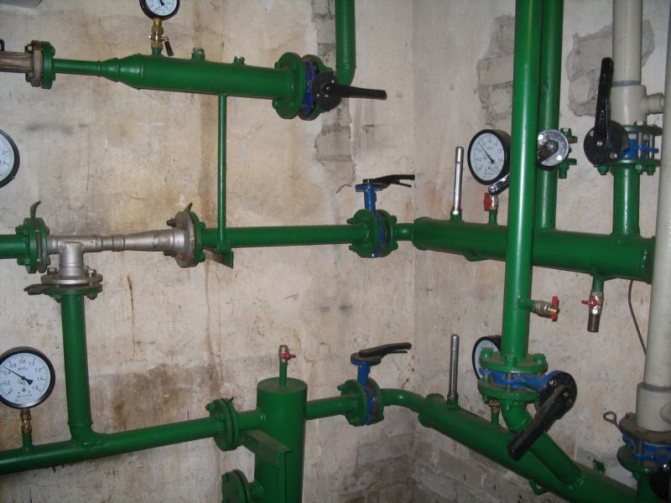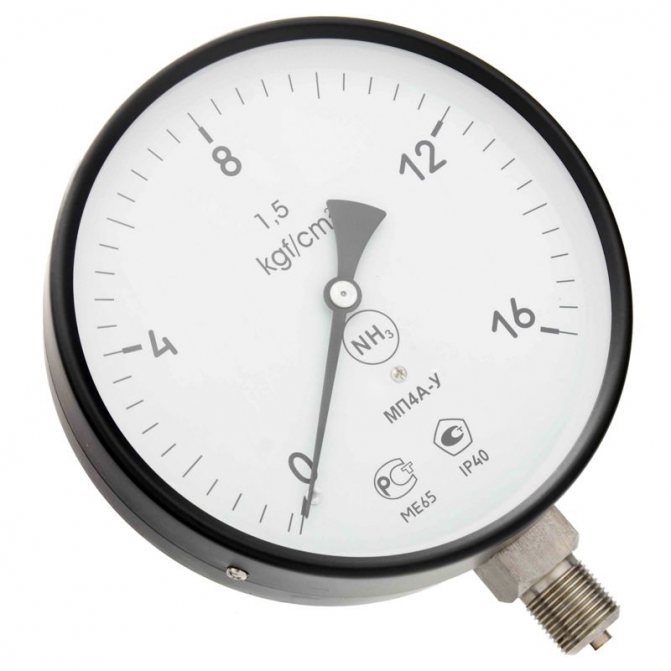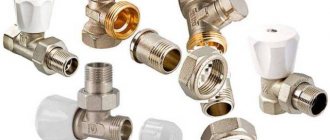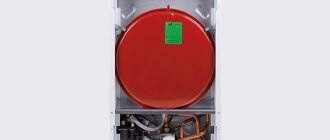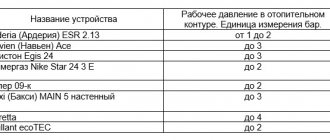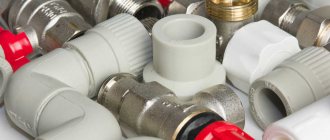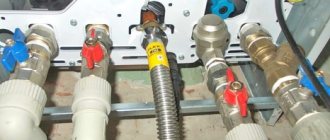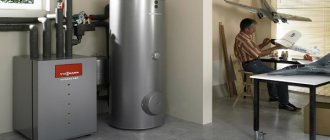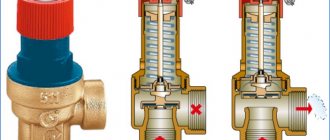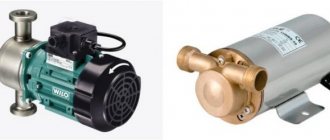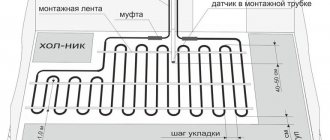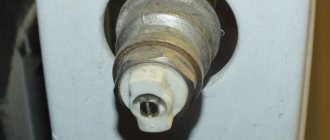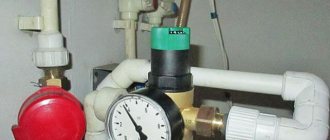Central heating system pressure
High pressure in the central heating system of an apartment building is necessary in order to raise the heating medium to the upper floors. In high-rise buildings, circulation occurs from top to bottom. The supply is carried out by boilers using blowers. These are electric pumps that propel hot water. The reading of the pressure gauge on the return flow depends on the height of the building. Knowing what pressure is assumed in the heating system of a multi-storey building, the appropriate equipment is selected. For a nine-story building, this figure will be approximately three atmospheres. The calculation is based on the assumption that one atmosphere raises the flow by ten meters. The height of the ceilings is approximately 2.75 m. We also take into account a five-meter gap to the basement and technical floor. Based on this calculation, you can find out what the pressure should be in the heating system of a multi-storey building of any height.
Distribution of temperatures and pressure in the elevator unit of an apartment building
The central city and housing and communal networks are separated by elevators. An elevator is a unit through which the coolant is supplied to the heating system of a high-rise building. It mixes the supply and return flow, depending on what pressure is required to heat an apartment building. The elevator has a mixing chamber with an adjustable opening. It's called a nozzle. Adjusting the nozzle allows you to change the temperature and pressure in the heating system of a multi-storey building. The hot water in the mixing chamber mixes with the water from the return flow and draws it into a new cycle. By changing the size of the nozzle orifice, you can decrease or increase the amount of hot water. This will lead to a change in temperature in the radiators of the apartments and a change in pressure. The temperature in the heating system of the house at the entrance is 90 degrees.
Temperature difference between supply and return
- With an average indicator outside the window of 0 ° C, the flow for radiators with different wiring is set at a level from 40 to 45 ° C, and the return temperature is from 35 to 38 ° C,
- At -20 ° C, the feed is heated from 67 to 77 ° C, and the return rate should be from 53 to 55 ° C,
- At -40 ° C, outside the window for all heating devices, the maximum permissible values are set.
- The supply is a coolant that goes through the radiators from a heat source.
- The return is a liquid that went through the entire circuit, and when it cooled down again got to the heat source for subsequent heating. Hence, occurs at the exit.
- Difference in temperature: return colder.
- The difference is in the installation. The water conduit that is attached to the top battery is feeding. What is attached to the bottom - return flow.
Causes of pressure drops in heating an apartment building
The return pressure in the heating of apartment buildings is lower than the supply. The normal deviation is two bars. In normal operation, the boiler houses supply the coolant to the system with a pressure of more than seven bars. The heating system of a high-rise building reaches about six bar. The flow is affected by hydraulic resistance, as well as branches in housing and communal networks. On the return line, the pressure gauge will show four bars. The pressure drop in the heating of an apartment building can be caused by:
- airlock;
- leakage;
- failure of system elements.
In practice, swings often occur.The water pressure in the heating system of an apartment building largely depends on the inner diameter of the pipes and the temperature of the coolant. Nominal technical marking - DU. For spills, pipes with a nominal bore of 60 - 88.5 mm are used, for risers - 26.8 - 33.5 mm.
Important! The pipes connecting the heating radiators and the riser must be of the same cross section. Also, the supply and return must be connected to each other before the battery.
The most important thing is that the apartment is warm. The hotter the water in the radiators, the higher the pressure in the central heating system of an apartment building. The return temperature is also higher. For stable operation of the heating system, the water from the return cycle pipe must be at a fixed temperature.
Ways to reduce heat loss
The above information will help to be used to correctly calculate the temperature rate of the coolant and will tell you how to determine the situations when you need to use the regulator.
But it is important to remember that the temperature in the room is influenced not only by the temperature of the coolant, outside air and the strength of the wind. The degree of insulation of the facade, doors and windows in the house should also be taken into account.
To reduce the heat loss of housing, you need to worry about its maximum thermal insulation. Insulated walls, sealed doors, plastic windows will help reduce heat leakage. It also reduces heating costs.
The efficient operation of the heating system determines how comfortable the temperature will be in the cold season in the house. Sometimes situations arise when hot water is supplied to the system, and the batteries remain cold. It is important to find the cause and eliminate it. To solve the problem, you need to know the design of the heating system and the reasons for the cold return during hot supply.
Elimination of drops
Elevator nozzle device
When the return flow temperature drops and the pressure in the heating pipes in an apartment building changes, the diameter of the elevator nozzle is adjusted. It is reamed out if necessary. This procedure must be agreed with the service provider (CHP or boiler house). Amateur performance should not be allowed. In extreme situations, when defrosting of the system is threatened, the adjustment mechanism can be completely removed from the elevator. In this case, the coolant enters the communications of the house without hindrance. Such manipulations lead to a decrease in pressure in the central heating system and a significant increase in temperature, up to 20 degrees. Such an increase can be dangerous for the heating system of the house and city networks in general.
An increase in the temperature of the working medium from the return flow is associated with an increase in the diameter of the nozzle, which leads to a decrease in pressure in the heating of apartment buildings. In order to lower the temperature, it should be decreased. Here you cannot do without welding. Then a new hole is drilled with a smaller drill. This will reduce the amount of hot water in the mixing chamber of the elevator. This manipulation is carried out after stopping the circulation of the coolant. If there is an urgent need, without stopping the system, to reduce the return temperature, the valves are partially closed. But this can be fraught with consequences. Metal shut-off valves create a barrier in the path of the coolant. The result is increased pressure and frictional force. This increases the wear on the dampers. If it reaches a critical level, the damper can come off the regulator and completely shut off the flow.
Warm as a battery
Suppose that the structures of the central network are reliably insulated along the entire route, the wind does not walk in attics, staircases and basements, the doors and windows in the apartments are insulated by conscientious owners.
Suppose that the coolant in the riser complies with building codes. It remains to find out what is the temperature of the heating batteries in the apartment.The indicator takes into account:
- outdoor air parameters and time of day;
- the location of the apartment in the plan of the house;
- living or utility room in the apartment.
Therefore, attention: it is important not what is the degree of the heater, but what is the degree of air in the room.
During the day, in corner rooms, the thermometer should show at least 20 ° C, and in centrally located rooms, 18 ° C is allowed.
At night in the dwelling, air is allowed at 17 ° C and 15 ° C, respectively.
Features of autonomous heating
The normal value for a closed circuit is 1.5-2.0 bar, which is much different from the pressure in the central heating pipes. The reason for the downgrade may be:
- depressurization - when a leak or microcracks appears, through which water can escape. Visually, this may not be noticeable, since a small amount of water has time to evaporate;
- decrease in the temperature of the coolant. The lower the water temperature, the less its expansion;
- the presence of autonomous pressure regulators that bleed air. They are installed to remove air pockets. Leak frequently;
- changing the radius of the nominal pipe passage. When heated, plastic pipes can change their geometry - they become wider.
Not only the circulation of the coolant depends on the pressure indicator in the heating system, but also the serviceability of the equipment. To prevent a decrease and increase in pressure in any part of the system, an expansion tank is installed. It is a metal container with a rubber membrane inside. The membrane divides the tank into two chambers: with water and air. At the top there is a valve through which air exits at extreme pressure rise. It can occur due to excessive heating of the fluid. After the water cools down and decreases in volume, the pressure in the system will not be enough, because the air has escaped. The volume of the expansion tank is calculated based on the total volume of the coolant in the system.
Radiator selection
It is important to choose the optimal radiator for the heating system
The temperature in the house also depends on the efficiency of the radiators. Manufacturers offer batteries in the following materials:
Each of the materials determines the working pressure of the radiator, its thermal power and the heat transfer coefficient. Before purchasing batteries, you should ask the housing office what the pressure is in the central heating. In a private house and in a high-rise building, the pressure is different:
- private up to 3 bar;
- the operating pressure in the heating system of an apartment building is 10 bar.
In addition, it is necessary to take into account periodic checks of the reliability of the heating system, the so-called water hammer.
And it is carried out in order to find out what is the pressure in heating in the apartment, to identify clogging, weak points and leaks. To remove dirt from the pipes, you need to turn off the valve and drain the water. Then dial the complete system and repeat the procedure. The use of special products with high acidity is allowed. This will require equipment. To find a leak or a weak spot in the heating system of a multi-storey building, it is necessary to increase the pressure to 10 bar. If any connection cannot withstand this load, it should be reinforced or replaced. It is best to spot weak spots as a result of water hammer in summer. Since it is much more difficult to carry out work of this kind in winter. This is due to the short period of time during which the system can unfreeze.
When organizing heating systems, undeservedly little attention is paid to the pressure in the system. For example, in the absence of a sufficient pressure drop between pipes and radiators, the coolant will "slip through" the radiator without heating it. The pressure drop in the heating system is a fairly common problem that can be dealt with quite simply.
The return of the heating battery is cold - device, reasons, remedies
Heating systems differ in the way of laying pipes. They can be laid in one-pipe and two-pipe ways. The most popular is the one-pipe wiring diagram. Most often it is installed in multi-storey buildings. It has the following advantages:
Cold return is a serious problem that must be eliminated. It entails many unpleasant consequences: the temperature in the room does not reach the desired level, the efficiency of the radiators decreases, there is no way to correct the situation with additional devices. As a result, the heating system does not work as it should.
Types of pressure in the heating system
The pressure in the heating system is the force with which liquids and gases act on the walls of the elements of the heating system, it is determined by the ratio to atmospheric pressure. Working pressure is the pressure that is present in a working system with normal operating characteristics. Working pressure is the sum of two values - static and dynamic pressure. (See also: )
Static pressure is a quantity measured when the water is stationary, taking into account its height.
Dynamic pressure is the effect of moving liquids or gases on the walls of the equipment.
The pressure drop is the pressure difference in the zones of supply and return of the coolant on the pumps.
The working pressure changes depending on the temperature of the heating medium. For example, at a temperature of +20 0 С this pressure is 1.3 bar, and at +70 0 С - 1.9 bar.
If the pressure in a single-circuit system is lower than the prescribed one, then the coolant will stagnate and will not give effective heat transfer from heating devices.
Installation of differential pressure regulators
In heating circuits with a variable flow rate of the coolant - on risers and horizontal sections of branches, the installation of pressure drop regulators makes it possible to exclude the influence on the branches of changes in the hydraulic regime of the system. They also help prevent noise generation on the control valves at high head. (See also: )
The installation of regulators allows for optimized regulation by increasing the role of control valves. Connecting impulse pipes before and after the control valve allows you to set the exact value of the flow rate of the coolant and prevent it from being exceeded.
Differential pressure regulators can be installed in the pump bypass line. They are used in systems with variable flow rate of the heating agent. Reducing the flow rate of the heating medium will increase the pressure drop between the suction and discharge nozzles. The regulator reacts to the increased differential by opening and bypassing the coolant from the pressure head to the suction nozzle, as a result of which the coolant flow through the pump remains constant.
The installation of pressure regulators creates stable barometric conditions for the functioning of the boiler and the heating system as a whole.
The use of materials is permitted only if there is an indexed link to the page with the material.
It is almost impossible to find old-style ovens used for heating and cooking. Long ago they were replaced by closed heating circuits involving the use of gas equipment. Even with correct installation, malfunctions of the heating system are possible. Why is this happening?
Automatic differential pressure regulator, good solution to the problem of differential pressure
Normal pressure in the system, affecting the quality of heating: if this parameter is outside the normal range - with the failure of expensive equipment.
With an increase in the indicator above the critical levels, the elements are destroyed, leading to a complete stop of the system. And by reducing it brings the liquid to a boil.Measures are urgently taken if the pressure in the heating system drops to a limit value of 0.02 MPa.
Heating is presented not in absolute, but in excess value. This parameter regulates the operation of heating systems and household boilers, and it is also fixed by a pressure gauge to measure water pressure.
Dependence of the coolant temperature on the outside air temperature
- If the room is corner, then the temperature regime should not fall below + 20 0 С, and in other rooms the temperature is not lower than +18 0 С, in the shower room not lower than +25 0 С. If the temperature outside drops to -30 0 С or lower, then all of the above indicators will increase to +22 0 С and 20 0 С, respectively;
- In rooms intended for children - from +18 0 С to +23 0 С. But even here the temperature regime depends on what this room is intended for. In swimming pools - not lower than +30 0 С, and on verandas for walking - not lower than +12 0 С;
- In children's schools - not less than 21 0 C, and in the bedrooms of boarding schools - not less than 16 0 C;
- In cultural institutions, the temperature ranges from 16 0 C to 21 0 C. For libraries - up to 18 0 C.
Also, taking into account this indicator, you can significantly save on costs when creating heating systems. If we consider this in terms of mass construction, then the amount that can be saved will be significant.
What the indicator is composed of
The working pressure is characterized by two parameters:
- Dynamic, which is created by circulation pumps.
- Static pressure determines the height of the water column inside the pipeline (an indicator of 1 atmosphere is created by 10 meters). That is, static pressure is a parameter indicating the force with which the fluid acts on radiators and pipes.
Working pressure (optimal) is characterized by an indicator that ensures the correct operation of the components of the heating system when all elements of the circuit are turned on.
Only specific types of batteries can withstand high system pressures. Bimetallic products do the best with this, while radiators made of one metal are poorly tolerated, manifesting themselves as drops in the heating network.
Consumer choice: cast iron or aluminum
The aesthetics of cast iron radiators is the talk of the town. They require periodic re-painting, as the rules stipulate that the work surface has a smooth surface and allows dust and dirt to be easily removed.
A dirty coating forms on the rough inner surface of the sections, which reduces the heat transfer of the device. But the technical parameters of cast iron products are at a height:
- slightly susceptible to water corrosion, can be used for more than 45 years;
- have a high thermal power per section, therefore they are compact;
- are inert in transferring heat, therefore they smooth out temperature changes in the room well.
Another type of radiator is made of aluminum. The lightweight construction, painted at the factory, does not require painting, and is easy to maintain.
But there is a drawback that overshadows the merits - corrosion in the aquatic environment. Of course, the inner surface of the heater is insulated with plastic to avoid contact of aluminum with water. But the film may be damaged, then a chemical reaction will begin with the release of hydrogen, when an excess gas pressure is created, the aluminum device may burst.
The temperature standards of heating radiators are subject to the same rules as batteries: it is not so much the heating of a metal object that is important, but the heating of the air in the room.
In order for the air to warm up well, there must be sufficient heat removal from the working surface of the heating structure. Therefore, it is categorically not recommended to enhance the aesthetics of the room with shields in front of the heating device.
How to control pressure
The nominal pressure is adjusted using the readings recorded on the measuring instruments. For this purpose, manometers are cut in.If the results deviate from the standard, urgently fix the problems, otherwise it will lead to a decrease in the efficiency of the equipment.
The pressure gauges are mounted on the pipeline at the following points:
- highest and lowest;
- after the boiler, filters and before it;
- at the entrance of heating networks into the house;
- when leaving the boiler room.
The optimum pressure inside the heating system is 1.5 to 2 atmospheres. The indicator is calculated when designing a house, taking into account the nuances of the equipment. In addition, the parameter depends on the number of floors. The pressure in the heating system of a multi-storey building reaches 12-16 atm.
Such a device is suitable for any heating system.
To optimize the performance, safety caps and air vents are used, which do not allow air locks to appear.
Sometimes, in order to minimize the uneven distribution of the coolant through the pipes, a balancing valve is used in the heating system. It is advisable to use it inside multi-storey buildings.
Regulators work as pressure limiters. Thanks to the device, the likelihood of accidents after water hammer is reduced and taps, pipes and mixers are better preserved.
Pressure and temperature are indicators on the level of which the heat inside the room depends.
The coolant is pumped in after assembling the heating units. Then create a head with a value of 1.5 atmospheres. When the liquid inside the pipes is heated, the pressure constantly increases. The correction of the indicator inside the heating network is made by changing the temperature of the liquid.
The norms are regulated by SNiP 41-01-2003 and differ at a specific point in the system. For a one-pipe scheme, it should not be more than 105 degrees, and for a two-pipe scheme, the maximum is +95 degrees.
In order to prevent too strong a pressure, expansion tanks are used. As soon as the indicator in the system becomes more than 2 atmospheres, the unit is triggered. Excess hot coolant is taken away by means of, while the pressure is normalized and kept at an optimal level.
When the capacity of the tank is not enough to collect excess water, the head in the heating system can reach 3 atmospheres, which is considered a critical indicator. The safety one helps to get out of the situation. The element frees the heating system from excess fluid as follows: the spring lifts the flap, after which excess water is removed from the line. The process continues until the parameter level stabilizes. Thus, the boiler safety valve preserves the equipment.
Before the heating season, the system is tested to see if it will withstand possible water hammer. For this, pressure testing is carried out and overpressure is created, after which weak sections of the pipeline are identified and measures are taken.
The functionality of the circuit is checked in 2 ways:
- By simultaneously checking the system.
- Checking specific sites.
The first option is beneficial only from the point of view of reducing time costs, but the second, despite the duration, deals with the integrity of the system in part, in specific areas. At the same time, it is easier to fix the found defect inside the covered area than to search for components.
Pressure meter
Allocate the established testing scheme:
- first, air is released from part of the circuit or the entire pipeline;
- then a pressure is supplied to the inside of the pipes, which exceeds the operating pressure by one and a half times.
- tightness test: first, chilled liquid is introduced into the pipes, then, after connecting the heating device, they are filled with hot coolant.
If there is no leakage and the pipe has not burst, there is no cause for concern.
Fluid leaking from the pipes minimizes the pressure. Often this problem occurs at the joints of elements, sometimes a breakthrough occurs when using defective or worn pipes.
A leak occurs if the pressure in the boiler drops, measured when the pumps are not running. If it is normal, then the problem is not inside the pipes, but in the pump. To detect a problem area, the sections of the circuit are turned off in turn, observing the change in indicators. When a defective area is found, it is cut off, repaired, joints are sealed or damaged components are replaced.
Additional reasons for the reduced rate:
- bithermal heat exchanger damaged during a water hammer;
- defective expansion tank chambers;
- the presence of scale inside the heat exchanger;
- pressure drops when using a heat exchanger with cracks (the reason is considered to be a factory defect, physical wear of the unit).
Specific approaches have been developed for a specific problem: the tanks are muffled, the heat exchanger is changed, and hard water is softened with additives.
First, they check the boiler and the heating regulator, due to a failure of which the movement of the coolant sometimes stops.
The indicator rises if the heating network is incorrectly fed; if the tap is closed in the direction of the circulating fluid; if dirt collectors or filters are clogged or boiler malfunctions are noticed.
After the heating system is put into operation, air comes out through the automatic taps on the radiators or vents, so a quick pressure optimization is not possible. To establish the operation of the circuit, liquid is additionally pumped there. If time passes, an increase in the indicator still makes itself felt, then the malfunctions are associated with an error in calculating the volume of the tank (expansion).
To avoid such problems, the nuances are considered even at the design stage of the house, and the installation is carried out strictly according to the established rules.
What should be the pressure in a high-rise building?
From this article you will find out what pressure in the heating system of a multi-storey building is considered normal, the reasons for its differences and how to troubleshoot. We will also talk about methods for checking the strength of the circuit and choosing the optimal radiators for the system.
Central heating system pressure
High pressure in the central heating system of an apartment building is necessary in order to raise the heating medium to the upper floors. In high-rise buildings, circulation occurs from top to bottom. The supply is carried out by boilers using blowers. These are electric pumps that propel hot water. The reading of the pressure gauge on the return flow depends on the height of the building. Knowing what pressure is assumed in the heating system of a multi-storey building, the appropriate equipment is selected. For a nine-story building, this figure will be approximately three atmospheres. The calculation is based on the assumption that one atmosphere raises the flow by ten meters. The height of the ceilings is approximately 2.75 m. We also take into account a five-meter gap to the basement and technical floor. Based on this calculation, you can find out what the pressure should be in the heating system of a multi-storey building of any height.
Distribution of temperatures and pressure in the elevator unit of an apartment building
The central city and housing and communal networks are separated by elevators. An elevator is a unit through which the coolant is supplied to the heating system of a high-rise building. It mixes the supply and return flow, depending on what pressure is required to heat an apartment building. The elevator has a mixing chamber with an adjustable opening. It's called a nozzle. Adjusting the nozzle allows you to change the temperature and pressure in the heating system of a multi-storey building. The hot water in the mixing chamber mixes with the water from the return flow and draws it into a new cycle. By changing the size of the nozzle orifice, you can decrease or increase the amount of hot water. This will lead to a change in temperature in the radiators of the apartments and a change in pressure.The temperature in the heating system of the house at the entrance is 90 degrees.
Changes in heating design
The replacement of existing heating devices in the apartment is carried out with the obligatory approval of the management company. Unauthorized changes in the elements of the heating radiation can disturb the thermal and hydraulic balance of the structure.
The heating season will begin, a change in the temperature regime in other apartments and areas will be recorded. A technical inspection of the premises will reveal an unauthorized change in the types of heating devices, their number and size. The chain is inevitable: conflict - court - fine.
Therefore, the situation is resolved as follows:
- if not old ones are replaced with new radiators of the same standard size, then this is done without additional approvals; the only thing to contact the UK for is to disconnect the riser for the duration of the repair;
- if new products differ significantly from those established during construction, then it is useful to interact with the management company.
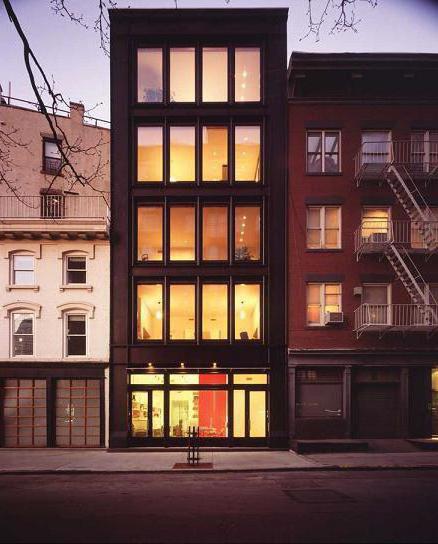
Causes of pressure drops in heating an apartment building
The return pressure in the heating of apartment buildings is lower than the supply. The normal deviation is two bars. In normal operation, the boiler houses supply the coolant to the system with a pressure of more than seven bars. The heating system of a high-rise building reaches about six bar. The flow is affected by hydraulic resistance, as well as branches in housing and communal networks. On the return line, the pressure gauge will show four bars. The pressure drop in the heating of an apartment building can be caused by:
- airlock;
- leakage;
- failure of system elements.
In practice, swings often occur. The water pressure in the heating system of an apartment building largely depends on the inner diameter of the pipes and the temperature of the coolant. Nominal technical marking - DU. For spills, pipes with a nominal bore of 60 - 88.5 mm are used, for risers - 26.8-33.5 mm.
Important! The pipes connecting the heating radiators and the riser must be of the same cross section. Also, the supply and return must be connected to each other before the battery.
The most important thing is that the apartment is warm. The hotter the water in the radiators, the higher the pressure in the central heating system of an apartment building. The return temperature is also higher. For stable operation of the heating system, the water from the return cycle pipe must be at a fixed temperature.
If the pressure rises
This situation is less common, but still possible. Its most likely cause is that there is no water movement along the contour. For diagnostics, we do the following:
- And again we recall the regulator - in 75% of cases, the problem is in it. To reduce the temperature in the network, it can cut off the supply of heat carrier from the boiler room. If it works for one or two houses, then it is possible that the devices for all consumers worked at the same time and stopped the flow.
It is necessary to investigate the settings and adjust them so that the regulators do not give an order to completely close the valves, its inertia will increase, but such situations will be excluded;
- Perhaps the system is under constant power supply (malfunction of automation or someone's negligence). As the simplest calculation shows, the more coolant in a limited volume, the higher the pressure. In this case, it is enough to shut off the power line or set up automation;
- If everything is in order with the control devices or the heating system does not turn them on at all, again we take into account the human factor in the first place - perhaps somewhere along the course of the coolant a tap or a valve is closed;
- The least likely situation is when an air lock interferes with the movement of the coolant - it is necessary to detect and remove it. A filter or a sump can also be clogged in the direction of the coolant movement;
Elimination of drops
Elevator nozzle device
When the return flow temperature drops and the pressure in the heating pipes in an apartment building changes, the diameter of the elevator nozzle is adjusted. It is reamed out if necessary. This procedure must be agreed with the service provider (CHP or boiler house). Amateur performance should not be allowed. In extreme situations, when defrosting of the system is threatened, the adjustment mechanism can be completely removed from the elevator. In this case, the coolant enters the communications of the house without hindrance. Such manipulations lead to a decrease in pressure in the central heating system and a significant increase in temperature, up to 20 degrees. Such an increase can be dangerous for the heating system of the house and city networks in general.
An increase in the temperature of the working medium from the return flow is associated with an increase in the diameter of the nozzle, which leads to a decrease in pressure in the heating of apartment buildings. In order to lower the temperature, it should be decreased. Here you cannot do without welding. Then a new hole is drilled with a smaller drill. This will reduce the amount of hot water in the mixing chamber of the elevator. This manipulation is carried out after stopping the circulation of the coolant. If there is an urgent need, without stopping the system, to reduce the return temperature, the valves are partially closed. But this can be fraught with consequences. Metal shut-off valves create a barrier in the path of the coolant. The result is increased pressure and frictional force. This increases the wear on the dampers. If it reaches a critical level, the damper can come off the regulator and completely shut off the flow.
The theory of linguistics
The name "battery" is a household name, meaning a number of identical items. With regard to heating a home, this is a series of heating sections.
The temperature standards of the heating batteries allow heating no higher than 90 ° C. According to the rules, parts heated above 75 ° C are fenced. This does not mean that they must be sheathed with plywood or bricked. Usually, a lattice fence is installed that does not impede air circulation.
Cast iron, aluminum and bimetallic devices are widespread.
Features of autonomous heating
The normal value for a closed circuit is 1.5-2.0 bar, which is much different from the pressure in the central heating pipes. The reason for the downgrade may be:
- depressurization - when a leak or microcracks appears, through which water can escape. Visually, this may not be noticeable, since a small amount of water has time to evaporate;
- decrease in the temperature of the coolant. The lower the water temperature, the less its expansion;
- the presence of autonomous pressure regulators that bleed air. They are installed to remove air pockets. Leak frequently;
- changing the radius of the nominal pipe passage. When heated, plastic pipes can change their geometry - they become wider.
Not only the circulation of the coolant depends on the pressure indicator in the heating system, but also the serviceability of the equipment. To prevent a decrease and increase in pressure in any part of the system, an expansion tank is installed. It is a metal container with a rubber membrane inside. The membrane divides the tank into two chambers: with water and air. At the top there is a valve through which air exits at extreme pressure rise. It can occur due to excessive heating of the fluid. After the water cools down and decreases in volume, the pressure in the system will not be enough, because the air has escaped. The volume of the expansion tank is calculated based on the total volume of the coolant in the system.
Radiator selection
It is important to choose the optimal radiator for the heating system
- private up to 3 bar;
- the operating pressure in the heating system of an apartment building is 10 bar.
In addition, it is necessary to take into account periodic checks of the reliability of the heating system, the so-called water hammer.
What is the pressure in the heating system for?
In this article, you will learn about the importance of pressure, methods of increasing or decreasing it, and the causes of pressure drops in the heating system. Also familiarize yourself with the equipment that is used to regulate and control pressure in heating.
Why do you need pressure in the heating system?
The working medium circulates in pipes and radiators. In this capacity, water most often acts. In order for it to circulate evenly, a constant pressure is required. Differences can lead to malfunctions and a complete stop of the process. Only overpressure (PR) is taken into account. Unlike absolute (ABD), it does not take into account atmospheric (ABD). The higher its value, the greater the efficiency.
ISD = ABD - ATD
AD is not a constant value. It varies depending on the altitude and weather conditions. On average, it is one bar.
How to create pressure in the heating system?
The pressure is static and dynamic.
Static systems are installed without the use of pumps. These are usually single-loop circuits. The pressure is created as a result of the height difference. Under its own weight from a height of ten meters, the water presses with a force of one bar.
Dynamic systems use pumps to increase the pressure in the heating system. These are more complex schemes that allow the installation of two and three circulation circuits. In other words, they simultaneously include:
- warm water floor;
- storage boilers.
The most important thing in heating is proper water circulation. In order for the liquid to move in the right direction, check valves are installed. The check valve is a coupling with a spring and a damper. It passes the liquid in only one direction, ensuring its correct circulation and high pressure in the heating system.
Control methods
You can control the pressure in the system using a sensor
For monitoring, water pressure sensors are installed in the heating system. These are pressure gauges with a Bredan tube, which is a measuring device with a scale and an arrow. It shows overpressure. It is installed at the control nodal points defined by regulatory documents. With the help of the pressure sensor of the heating system, it is possible to determine not only a quantitative indicator, but also areas with possible leaks and other malfunctions.
The flow of the working medium does not pass directly through the pressure gauge, since the measuring device is installed by means of three-way valves. They allow you to purge the gauge or reset the readings. Also, this tap allows you to replace the pressure gauge by simple manipulations.
Pressure gauges are installed before and after elements that can affect losses and pressure rise in the heating system. Also, using it, you can determine the health of a particular unit.
Key nodes
- , electric or solid fuel
Each of them has certain characteristics. The volume of the liquid that it is able to heat, as well as the allowable pressure, depends on these values.
- Expansion tank
Used in closed-loop dynamic systems. Consists of two chambers: in one air, and in the second liquid. The chambers are separated by a membrane. There is a valve in the air compartment through which, if necessary, bleeding takes place. The main purpose is to adjust the pressure drops in the heating system.
- Electric pressure blower
- Heating control devices
- Filters
Fluctuations and their causes
Pressure surges indicate system malfunction.The calculation of pressure losses in the heating system is determined by summing the losses at individual intervals, which make up the entire cycle. Early identification of the cause and its elimination can prevent more serious problems that lead to costly repairs.
If the pressure in the heating system drops, this may be due to the following reasons:
- the appearance of a leak;
- failure of the expansion tank settings;
- failure of pumps;
- the appearance of microcracks in the boiler heat exchanger;
- power outage.
Expansion tank regulates differential pressure
In the event of a leak, all connection points must be checked. If the cause is not visually identified, it is necessary to examine each area separately. For this, the valves of the taps are sequentially closed. The pressure gauges will show the change in pressure after cutting off a particular section. Having found a problematic connection, it must be tightened, previously additionally sealed. If necessary, the assembly or part of the pipe is replaced.
The expansion tank regulates the differences due to heating and cooling of the liquid. A sign of a tank malfunction or insufficient volume is an increase in pressure and a further drop.
The calculation of the pressure in the heating system necessarily includes the calculation of the volume of the expansion tank:
(Thermal expansion for water (%) * Total volume in the system (l) * (Maximum pressure level + 1)) / (Maximum pressure level - Pressure for gas in the tank itself)
Add a clearance of 1.25% to this result. The heated liquid, expanding, will force air out of the tank through the valve in the air compartment. After the water cools down, it will decrease in volume and the pressure in the system will be less than required. If the expansion tank is smaller than required, it must be replaced.
A rise in pressure can be caused by a damaged membrane or an incorrect setting of the heating system pressure regulator. If the diaphragm is damaged, the nipple must be replaced. It's quick and easy. To configure the reservoir, it must be disconnected from the system. Then pump the required amount of atmospheres into the air chamber with a pump and install it back.
You can determine the malfunction of the pump by turning it off. If nothing happens after the shutdown, then the pump is not working. The reason may be a malfunction of its mechanisms or a lack of power. You need to make sure that it is connected to the network.
If there are problems with the heat exchanger, then it must be replaced. During operation, microcracks may appear in the metal structure. This cannot be eliminated, only replacement.
Why is the pressure in the heating system increasing?
The reasons for this phenomenon may be incorrect fluid circulation or its complete stop due to:
- the formation of an air lock;
- clogging of the pipeline or filters;
- operation of the heating pressure regulator;
- continuous feeding;
- shutoff valves overlapping.
How to eliminate drops?
An air lock in the system does not allow fluid to pass through. The air can only be vented. To do this, during installation, it is necessary to provide for the installation of a pressure regulator for the heating system - a spring air vent. It works in automatic mode. The radiators of the new design are equipped with similar elements. They are located at the top of the battery and operate in manual mode.
Why does the pressure in the heating system increase when dirt and scale accumulates in the filters and on the pipe walls? Because the flow of fluid is obstructed. The water filter can be cleaned by removing the filter element. It is more difficult to get rid of scale and blockages in pipes. In some cases, flushing with special means helps. Sometimes the only way to fix the problem is.
The heating pressure regulator, in the event of an increase in temperature, closes the valves through which the liquid enters the system.If this is unreasonable from a technical point of view, then the problem can be rectified by adjusting. If this procedure is not possible, the assembly should be replaced. If the electronic make-up control system breaks down, it should be adjusted or replaced.
The notorious human factor has not yet been canceled. Therefore, in practice, the shut-off valves overlap, which leads to the appearance of increased pressure in the heating system. To normalize this figure, you just need to open the valves.
How to make radiators hot - looking for solutions
If it is found that the return is too cold, a series of troubleshooting steps should be taken. First of all, you need to check the correctness of the connection. If the connection is not correct, the down pipe will be hot, but should be slightly warm. Connect the pipes according to the diagram.
So that there are no air locks that impede the advancement of the coolant, it is necessary to provide for the installation of a Mayevsky valve or a vent for air removal. Before bleeding air, shut off the supply, open the tap and release the air. Then the tap is closed and the heating valves are opened.
Often the reason for the cold return is the control valve: the section is narrowed. In this case, the crane must be dismantled and the cross-section must be increased using a special tool. But it is better to buy a new tap and replace it.
The reason may be a clogged pipe. It is necessary to check them for permeability, remove dirt, deposits, and clean well. If the passability could not be restored, the clogged areas should be replaced with new ones.
If the speed of movement of the coolant is insufficient, it is necessary to check whether there is a circulation pump and it meets the power requirements. If it is absent, it is advisable to install it, and if there is a lack of power, replace or modernize.
Knowing the reasons why the heating may work ineffectively, you can independently identify and eliminate malfunctions. Comfort in the house during the cold season depends on the quality of heating. If you carry out the installation work yourself, you can save on hiring outside labor.
With a large temperature difference between the supply and return of the boiler, the temperature on the walls of the combustion chamber of the boiler approaches the dew point temperature and condensation is possible. It is known that during the combustion of fuel, various gases are released, including CO 2, if this gas combines with the "dew" that has fallen on the walls of the boiler, an acid is formed, which corrodes the "water jacket" of the boiler furnace. As a result, the boiler can be quickly damaged. To prevent dew loss, it is necessary to design the heating system in such a way that the temperature difference between the supply and return is not too large. This is usually achieved by heating the return coolant and / or including a hot water boiler with a soft priority in the heating system.
To heat the coolant between the return flow and the boiler supply, a bypass is made and a circulation pump is installed on it. The power of the recirculation pump is usually chosen as 1/3 of the power of the main circulation pump (the sum of the pumps) (Fig. 41). In order to prevent the main circulation pump from “pushing” the recirculation loop in the opposite direction, a check valve is installed downstream of the recirculation pump.
Fig. 41. Return heating
Another way to heat the return flow is to install a hot water supply boiler in the immediate vicinity of the boiler. The boiler is "set" on a short heating ring and positioned in such a way that hot water from the boiler after the main distribution manifold immediately enters the boiler, and from it returns back to the boiler. However, if the demand for hot water is small, then both a recirculation ring with a pump and a heating ring with a boiler are installed in the heating system.With proper calculation, the recirculation pump ring can be replaced with a system with three- or four-way mixers (Fig. 42).
Fig. 42. Heating the return flow using three- or four-way mixers On the pages "Control equipment of heating systems" were listed almost all technically significant devices and engineering solutions present in classic heating circuits. When designing heating systems on real construction sites, they should be fully or partially included in the project of heating systems, but this does not mean that exactly the heating fittings that are indicated on these pages of the site should be included in a specific project. For example, on the make-up unit, shut-off valves with built-in check valves can be installed, or these devices can be installed separately. Mud filters can be installed instead of mesh filters. An air separator can be installed on the supply pipelines, or it is possible not to install it, but to mount automatic air vents instead of it at all problem areas. On the return line, you can install a deslimator, or you can simply equip the collectors with drains. Adjustment of the temperature of the coolant for the "warm floor" circuits can be done with a qualitative adjustment with three- and four-way mixers, and you can make a quantitative adjustment by installing a two-way valve with a thermostatic head. Circulation pumps can be installed on a common supply pipe or vice versa, on the return. The number of pumps and their location can also vary.
When autumn confidently strides across the country, snow is flying beyond the Arctic Circle, and in the Urals night temperatures are kept below 8 degrees, the word “heating season” sounds appropriate. People remember the past winters and try to figure out the temperature of the coolant in the heating system.
The prudent owners of individual buildings carefully inspect the valves and nozzles of the boilers. Residents of an apartment building by October 1 are waiting, like Santa Claus, a plumber from the management company. The lord of gates and gates brings warmth, and with him - joy, fun and confidence in the future.

